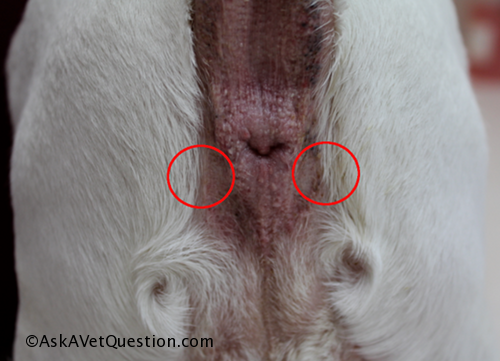What are anal glands?
If you find this information useful, please spread the word by sharing this on Facebook with your friends or Tweeting this article.
Click here to Follow Dr. Marie on Twitter or here to Become a Facebook Fan.
The correct term for anal glands is actually, "anal sacs". There is a sac located on either side of the anus at about the 4 and 8 o'clock position. The sacs contain many little glands that secrete material.
We don't really know the purpose of anal glands in dogs. Some animals, such as skunks, can voluntarily spray the contents of their glands. But dogs and cats don't empty their glands consciously.
The material inside the sacs is made up of a mixture of bacteria and glandular debris. It is usually quite unpleasant! The following types of material can be in a normal dog's anal sac:
- Tan liquid
- Thick dark brown debris
- Tan liquid with little black flecks
- Something that looks like peanut butter
What is that fishy smell?
Dogs will sometimes empty their glands involuntarily. This can often happen if a dog is suddenly scared. If you suddenly notice a fishy smell coming from your dog, have a sniff of his or her back end to see if that is where the smell is coming from. If so, it is usually nothing to worry about. But, if it is happening often then it may be time to have your vet empty the glands.
Symptoms of full anal glands
- "Scooting", or dragging their bum on the ground. (See the video to the right.)
- Licking the anus regularly.
- Repeatedly sitting down suddenly.
- Looking back suddenly at the anus as if something was suddenly sore.
Some dogs will have other symptoms as well. I have seen dogs that will vomit periodically when their glands are full. Some dogs will cough when their glands are full as well.
Serious Anal Gland Problems
If the anal glands get too full they can get impacted and this can cause serious discomfort to the dog. If an impacted gland is left untreated then bacteria builds up and the dog can get an anal sac infection, or even an anal sac abscess.
If you see any of the following symptoms then it means that there is a serious problem with the anal glands and your dog should see a vet right away:
- A visible swelling over one or both of the glands.
- A red boil or blister over one of both of the glands.
- Discharge from the glands that has blood in it.
Dogs can also get tumors affecting the anus or the anal glands as well.
Expressing anal glands internally or externally?
Most groomers who express anal glands will do so externally. I don't recommend this because usually the entire gland is not emptied. Instead, we will talk about the more effective way of emptying anal glands - Internal expression.
How to express your dog's glands.
Before reading this tutorial, please know that expressing a dog's anal glands properly is usually not easy! I do not recommend trying this at home unless you have a very well behaved dog. Definitely do not try this at home if your dog has a swelling or boil near the anus. This means that there is an infection or abscess and needs to be treated by a vet.
The video to the left is of me expressing a dog's anal glands at my clinic. Here are the steps that you need to take if you would like to try this at home.
It is best to do this on a table and with someone standing at the dog's side holding up the abdomen so that he or she does not try to sit.
 Put on a pair of latex gloves and coat your right index finger with a lubricant such as K-Y Jelly or Vaseline. Have a paper towel or rag handy in your left hand.
Put on a pair of latex gloves and coat your right index finger with a lubricant such as K-Y Jelly or Vaseline. Have a paper towel or rag handy in your left hand.
 Stand on the dog's left side and slightly behind the dog. Insert your finger into the anus. Your thumb will be on the outside of the gland.
Stand on the dog's left side and slightly behind the dog. Insert your finger into the anus. Your thumb will be on the outside of the gland.
 Gently squeeze your thumb and finger together. The gland will empty out into the anus. Keep the paper towel over your hand otherwise the material may spray and that's really gross! You may need to massage the gland a bit to get it to fully empty.
Gently squeeze your thumb and finger together. The gland will empty out into the anus. Keep the paper towel over your hand otherwise the material may spray and that's really gross! You may need to massage the gland a bit to get it to fully empty.
 Remove your finger and now insert your thumb. Put your finger on the outside of the gland. Then squeeze the right sac, just as you did the left.
Remove your finger and now insert your thumb. Put your finger on the outside of the gland. Then squeeze the right sac, just as you did the left.
 Clean up time! Use a soaked cloth or paper towel and some mild soap to wash the bum clean. If you have some, use a doggy odor spray such as Earthbath Vanilla Almond Dog Spray. Or you can use Men's Speedstick to help reduce the smell.
Clean up time! Use a soaked cloth or paper towel and some mild soap to wash the bum clean. If you have some, use a doggy odor spray such as Earthbath Vanilla Almond Dog Spray. Or you can use Men's Speedstick to help reduce the smell.
Leave a comment below!
(Dr. Marie does not answer questions via the comments section, though!)
Dr. Marie was quick to respond and thorough in suggesting treatment for my cat. I am so thankful- I have been so worried about my cat. Now I have additional options to discuss with my vet.
The service was incredibly fast and the vet's suggestions were right on target. This was incredibly helpful given that none of the vets in my area, mine now included, will take off hours calls now.
- Ask A Vet Question now has a new site layout!
- Listen for Dr. Marie on 580 CFRA radio in Ottawa on "Ask the Veterinarian" with John Counsell.
 Dr. Marie is a veterinarian who practices in a busy animal hospital in Ottawa, Ontario. She created Ask A Vet Question as a resource for good, accurate veterinary advice online. Dr. Marie treats dogs, cats, hamsters, guinea pigs, and rats. She has been a vet since 1999.
Dr. Marie is a veterinarian who practices in a busy animal hospital in Ottawa, Ontario. She created Ask A Vet Question as a resource for good, accurate veterinary advice online. Dr. Marie treats dogs, cats, hamsters, guinea pigs, and rats. She has been a vet since 1999.
Is an online vet visit just as good as a trip to your veterinarian? No! But, many times, asking an online veterinarian a question can help save you money. While Dr. Marie can't officially diagnose your pet or prescribe medications, she can often advise you on whether a vet visit is necessary. You can also ask Dr. Marie for a second opinion on your pet's condition.















